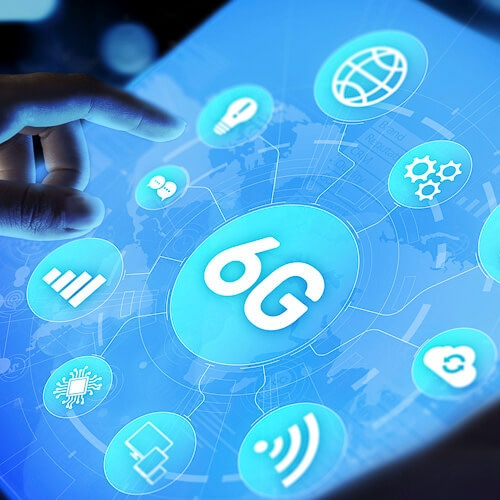
WASHINGTON – A two-day gathering here to promote the progress of 6G wireless yielded some striking parallels to 5G – as in, the sales pitches ventured for the current generation of wireless broadband back when it was still a nebulous next generation.
As if it were 2016 again, speakers here at the 6GSymposium Fall 22 event said large-scale adoption of augmented- and virtual-reality technologies would render today's wireless inadequate – and would drive the deployment of tomorrow's. But because this event took place in 2022, they said "metaverse" instead of abbreviations like AR and VR.
"It's probably the metaverse, in some way, shape or form," Ray Dolan, CEO of technology vendor Cohere Technologies, said during a panel Tuesday morning as this conference kicked off at the Hotel Washington before an audience of perhaps a few hundred industry professionals.
"I think the metaverse will be transformative," Paul Challoner, a North American VP of equipment vendor Ericsson, predicted in another session. "5G is a great starting point, but we're going to need 6G to handle the metaverse."
"The metaverse is really where all the network requirements seem to have the highest value," Dan Shey, a VP at research and consulting company ABI Research, chimed in during a separate session in the afternoon.
Out-there use cases
Cathy Hackl, chief metaverse officer and founder at AR/VR developers Journey, put a little meat on those metaverse bones in an afternoon presentation Tuesday.
"We are on a race to replace the mobile phone with something else," she said. "Many of us do believe it's some type of wearable."
Hackl then played a concept video clip in which a young woman wakes up and puts on glasses that looked like today's analog eyewear but incorporated digital displays.
Those smart glasses then augment her day by displaying her calendar for a schedule check, brightening her bicycle commute by having balloons float out of skyscrapers, and preventing office awkwardness by displaying a virtual nametag above a co-worker's head.
Back at home, the AR eyewear performed a culinary impression of Microsoft's Clippy as the woman turned her attention to dinner: "It seems like you're making lasagna. Should I turn on the oven?"
Figure 1:  (Source: Kirill Ivanov / Alamy Stock Photo)
(Source: Kirill Ivanov / Alamy Stock Photo)
In the symposium's final panel Wednesday evening, David Krauss, principal network architect for advanced architectures at equipment vendor Ciena, suggested that the smart-glasses scenario was not advanced enough. He instead suggested that a brain-computer interface, along the lines of Elon Musk's Neuralink, could prove to be a superior option.
Should people plug into this feature (even if that doesn't involve a literal socket in their heads), speed and latency needs would certainly increase.
"If you're streaming YouTube, you don't have to worry about latency. If you're doing VR, you do have to worry about latency," said Ericsson's Challoner. "Augmented reality has the additional problem of, I need to have video on the uplink from the device."
High-frequency hopes
Back when VR was going to vault 5G into commercial relevance – along with autonomous vehicles, immersive video calling and other use cases cited for 6G during the event – many industry types said the required fast, low-latency bandwidth would come from greenfield millimeter-wave (mmWave) spectrum.
But then operators started learning how difficult it would be to cover a city with mmWave, given its severe coverage limits, and braked that network investment. Lately, real speed upgrades in 5G have come from the deployment of midband spectrum in the US.
(The symposium venue itself underscored what a disappointment mmWave has been: Verizon's mmWave service doesn't get within half a block of the hotel's entrance).
With that history in mind and with 6G advocates already talking up the potential of bands above 100 GHz, FCC Chairwoman Jessica Rosenworcel used part of her MWC Barcelona keynote this February to warn against getting high-frequency hopes up, saying "These waves are fragile and while there's a lot of this spectrum to deploy, it doesn't travel very far."
At the symposium, however, multiple speakers pointed to sub-terahertz spectrum as the way to light up 6G.
"The reason why we're going with sub-terahertz is that we get high bandwidth and very high capacity," said Ali Khayrallah, a senior scientist in Ericsson's global CTO office. "We already do backhaul in some of these bands, so it's not like we're crazy."
Roger Nichols, 6G program director at testing equipment vendor Keysight, said supply alone suggested looking to sub-terahertz, with the 110-170 GHz D band the most popular in considerations right now: "That's where you find spectrum – there's just that much of it."
But as Khayrallah said in that same Wednesday-afternoon panel: "We can't beat physics."
For example, Rohde & Schwarz has conducted tests at its Munich campus of 158 GHz point-to-point transmissions – with a range of up to 170 meters. Andreas Roessler, principal engineer at Rohde & Schwarz, discussed those tests during a Tuesday session.
Smart reflectors, lower frequencies and other possibilities
A day later, Northeastern University engineering professor Josep Jornet offered hope for much better performance, saying his university's Ultrabroadband Nanonetworking Laboratory would release a paper by the end of the year documenting successful line-of-sight demonstrations in sub-terahertz bands at 2 kilometers' distance. He didn't provide specifics though.
Jornet and other speakers also alluded to the potential of "smart reflectors" – adaptive surfaces that track nearby devices to orient radio waves towards them.
In his panel, Challoner endorsed embedding what he called "metamaterials" into walls, ceilings and other bits of the built environment. It evoked today's proposals to build out mmWave 5G in urban areas by deploying "smart repeaters" – except in this scenario, the resulting mesh network would involve far more nodes.
These reflectors would also use far less energy, perhaps none – although symposium speakers only mentioned that in passing. As explained in such research papers as a July 2019 IEEE report, the nearly-passive state of these reflectors would allow them to operate either on batteries alone or via harvesting energy from such ambient sources as the RF environment.
As with smart repeaters, smart reflectors would seem to be a scalable solution only for dense, urban environments.
Everywhere else, deploying 6G looks to be an easier lift on lower frequencies, with multiple speakers citing 7 to 24 GHz as the most interesting range. "Value still is going to be in the midband spectrum," said Manu Gosain, senior director of technical programs at Northeastern University.
But that's a much more encumbered space than sub-terahertz frequencies, with multiple incumbent users to accommodate if not relocate.
Andrew Thiessen, head of 5G and xG at vendor MITRE Corp. and chair of the Next G Alliance's spectrum working group warned: "We're going to have to evolve ways of sharing spectrum that are well beyond what we see in things like CBRS."
Or as Rohde & Schwarz's Roessler put it: "6G should be a great symphony" – but its instruments will need careful and precise conduction.
Commercial considerations
The subject of how to pay for all these advances – and which flavors of 6G could become commercially viable – got somewhat less attention. But the topic did not go unmentioned during the symposium.
"Can there be a flavor of 6G that will have much lower costs that's optimized for closing the digital divide?" asked former Qualcomm exec Dean Brenner, now chair of the FCC's Technological Advisory Council, Tuesday morning. "The challenge is to deliver something that's really great at a lower cost."
Some of the more enthusiastic metaverse evangelism got some pushback on those grounds, with MITRE's Thiessen suggesting that 6G would be irrelevant to at-home VR consumption: "I'm still kind of challenged on why I need 6G to cut the cable on my VR headset at home."
With speakers concurring that large-scale 6G commercial service would not happen before 2030, this would seem to require wireless carriers to place very large bets – easily tens of billions of dollars in spectrum auctions – on the odds of Mark Zuckerberg's metaverse dreams coming true.
And a brutal WSJ report published Monday suggested that skepticism about mass-market metaverse appeal was well placed, noting that Meta's flagship virtual world was "currently reaching less than the population of Sioux Falls, S.D."
But even 6G pitches that don't assume subscribers will wear computers on their faces could get complicated if 6G follows 5G's pattern of delivering wildly varying service depending on frequencies and locations.
In a panel Wednesday, Marc Price, CTO of the telecom revenue-management firm Matrixx Software, hypothesized about monetizing the ultra-low latency that 6G might deliver (as low as .1 millisecond, per Shey's presentation). Gamers and financial traders would value that enough to pay for it, he said – but only if they can count on it everywhere.
"That means I have to be able to control the entire experience, from the device to the tower, from the radio to the core," he said. "If I'm a trader, I'm not going to be happy with an SLA [service level agreement] just within the part of the network that's controlled by the operator."
Fortunately, that same long timeline gives network operators a lot of runway to decide where to place their investments.
And it ensures we should be able to wait a while longer for the inevitable hype of a next, next-generation architecture. As Ian Wong, director of RF and wireless architecture at the network-testing firm Viavi, said in the symposium's penultimate panel: "It's definitely too early for 7G."
— Rob Pegoraro, special to Light Reading. Follow him @robpegoraro.
About the Author(s)
You May Also Like











